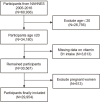The association between the vitamin B1 intake and risk of non-melanoma skin cancer in U.S. adults: a cross-sectional study
- PMID: 40370794
- PMCID: PMC12075143
- DOI: 10.3389/fnut.2025.1571991
The association between the vitamin B1 intake and risk of non-melanoma skin cancer in U.S. adults: a cross-sectional study
Abstract
Background: The incidence of non-melanoma skin cancer (NMSC) has been steadily increasing in recent years, primarily due to global climate change and heightened exposure to ultraviolet (UV) radiation. This trend is particularly pronounced among Caucasians, whose lack of melanin in skin cells renders them more susceptible to UV-induced damage. Although NMSC is associated with low mortality, its high incidence imposes a significant economic burden on society. Consequently, identifying novel risk factors and predictors has become increasingly important. Growing attention has been directed toward the relationship between diet and diseases, including cancer. While research on dietary factors and NMSC has gained momentum, studies specifically examining the link between vitamin B1 intake and NMSC remain limited. Therefore, this study aims to explore the potential association between vitamin B1 consumption and the risk of developing NMSC.
Methods: The authors conducted a cross-sectional study utilizing data from six cycles of the National Health and Nutrition Examination Survey (NHANES) database spanning 2005 to 2016. Out of 60,936 participants initially identified, 30,982 individuals who did not meet the study criteria were excluded, resulting in a final sample of 29,954 participants. In this study, the exposure variable was vitamin B1 intake. This was calculated by counting the amount of vitamin B1 contained in food consumed over a 24-h period. Outcome variable was presence of non-melanoma skin cancer. For the analysis of bivariate variables, multiple linear regression models were primarily employed. Additional analyses included curve fitting and subgroup analysis to further explore the relationships and trends.
Results: The mean age of participants included in the analysis was 49.66 years, with an approximately equal male-to-female ratio. Among these, 499 individuals were diagnosed with NMSC, with a mean age of 68.27 years and a prevalence rate of 1.67%. The probability of having NMSC was positively correlated with vitamin B1 consumption, according to logistic regression analysis. Specifically, an 11% increased incidence of NMSC was linked to every unit increase in vitamin B1 consumption. The risk rose by up to 1.65 times in those with high vitamin B1 consumption, making this link more noticeable. A linearly positive relationship between vitamin B1 consumption and NMSC risk was found using smoothed curve fitting. Subgroup analyses confirmed that this positive association remained consistent across different population subgroups.
Conclusion: This study identified a positive association between vitamin B1 intake and NMSC. However, due to the inherent limitations of cross-sectional studies, further prospective studies are needed to confirm the causal relationship.
Keywords: NHANES; cross-sectional study; dietary; non-melanoma skin cancer; vitamin B1.
Copyright © 2025 Huang, Shi, Ma, Zhu, Liang and Huang.
Conflict of interest statement
The authors declare that the research was conducted in the absence of any commercial or financial relationships that could be construed as a potential conflict of interest.
Figures



Similar articles
-
The association between dietary vitamin B1 intake and constipation: a population-based study.BMC Gastroenterol. 2024 May 17;24(1):171. doi: 10.1186/s12876-024-03255-2. BMC Gastroenterol. 2024. PMID: 38760704 Free PMC article.
-
Association between vitamin B1 intake and hyperuricemia in adults.Sci Rep. 2024 Jul 16;14(1):16428. doi: 10.1038/s41598-024-66384-4. Sci Rep. 2024. PMID: 39013961 Free PMC article.
-
Associations between dietary and supplemental vitamin A intake and melanoma and non-melanoma skin cancer.Skin Health Dis. 2024 Oct 2;4(6):e462. doi: 10.1002/ski2.462. eCollection 2024 Dec. Skin Health Dis. 2024. PMID: 39624744 Free PMC article.
-
Beverage Consumption and Growth, Size, Body Composition, and Risk of Overweight and Obesity: A Systematic Review [Internet].Alexandria (VA): USDA Nutrition Evidence Systematic Review; 2020 Jul. Alexandria (VA): USDA Nutrition Evidence Systematic Review; 2020 Jul. PMID: 35349233 Free Books & Documents. Review.
-
Dietary glycation compounds - implications for human health.Crit Rev Toxicol. 2024 Sep;54(8):485-617. doi: 10.1080/10408444.2024.2362985. Epub 2024 Aug 16. Crit Rev Toxicol. 2024. PMID: 39150724
References
-
- Skin Cancer Facts & Statistics . The Skin Cancer Foundation. Available online at: https://www.skincancer.org/skin-cancer-information/skin-cancer-facts/ (Accessed December 22, 2024)
-
- Global Burden of Disease Cancer Collaboration. Fitzmaurice C, Abate D, Abbasi N, Abbastabar H, Abd-Allah F, et al. . Global, regional, and National Cancer Incidence, mortality, years of life lost, years lived with disability, and disability-adjusted life-years for 29 Cancer groups, 1990 to 2017: a systematic analysis for the global burden of disease study. JAMA Oncol. (2019) 5:1749–68. doi: 10.1001/jamaoncol.2019.2996, PMID: - DOI - PMC - PubMed
LinkOut - more resources
Full Text Sources

